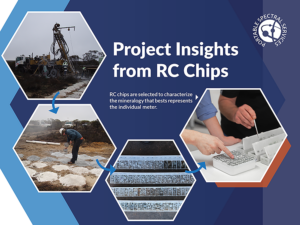
Automated Capture of AC/RC Chip mineralogy
Automated micro-X-ray fluorescence (micro XRF) technology emerges as a powerful tool to rapidly and accurately capture the mineralogy of rock chip, RC and AC samples.

At PSS, we are introducing a cutting-edge visualization tool for mineral data analysis of reverse circulation (RC) rock chips, transforming how exploration geologists understand subsurface mineral composition.
Reverse circulation (RC) drilling is a widely-used, versatile exploration technique in mining. This method rapidly generates rock chips, which represent geological material at various depths as the drill progresses down a hole. These rock chips provide a valuable snapshot of mineral composition and structural changes within the subsurface layers. Approximately 90% of Australia’s drill holes use reverse circulation drilling.
Historically, RC chip drilling offers a fast means of gathering geological data, primarily through bulk geochemical sampling. Mineralogical data is often logged directly in the field by a geologist based on visual observations. This method, while practical, has several inherent limitations:

Our tool introduces uXRF (micro-X-ray fluorescence) scanning technology to RC chip analysis, enabling rapid, non-destructive, and quantitative analysis of major, minor, and trace mineral phases.
By linking each chip’s mineral data to its exact depth, our visualization tool can represent mineralization trends throughout the drill hole.


Thanks to high-resolution imaging and proprietary object identification code, we can quantify the colour, shape, and morphology of chips throughout the drill hole. This allows for:
Our goal at PSS is to address the fundamental questions geologists and exploration teams have about their subsurface findings. Through this advanced data, we can answer pressing geological questions and empower exploration projects with a wealth of precise, actionable information.


James Waldron
Team Lead – Spectral Geologist

Dr. Jason Bennett
Senior Spectral Mineralogist

Mel Hartley
Software & Automation Engineer

Evie Burton
Spectral Geologist

Kyle Halse
Software Developer

Automated micro-X-ray fluorescence (micro XRF) technology emerges as a powerful tool to rapidly and accurately capture the mineralogy of rock chip, RC and AC samples.

Findings of an ongoing regional evaluation study over concealed Proterozoic lithologies known to host magmatic nickel sulphides with potential to host other base-metal, gold and rare earth elements (“REE”) systems within the Fraser Range, Western Australia.

Findings of an ongoing regional evaluation study over concealed Proterozoic lithologies known to host magmatic nickel sulphides with potential to host other base-metal, gold and rare earth elements (“REE”) systems within the Fraser Range, Western Australia.

Findings of an ongoing regional evaluation study over concealed Proterozoic lithologies known to host magmatic nickel sulphides with potential to host other base-metal, gold and rare earth elements (“REE”) systems within the Fraser Range, Western Australia.

Findings of an ongoing regional evaluation study over concealed Proterozoic lithologies known to host magmatic nickel sulphides with potential to host other base-metal, gold and rare earth elements (“REE”) systems within the Fraser Range, Western Australia.
